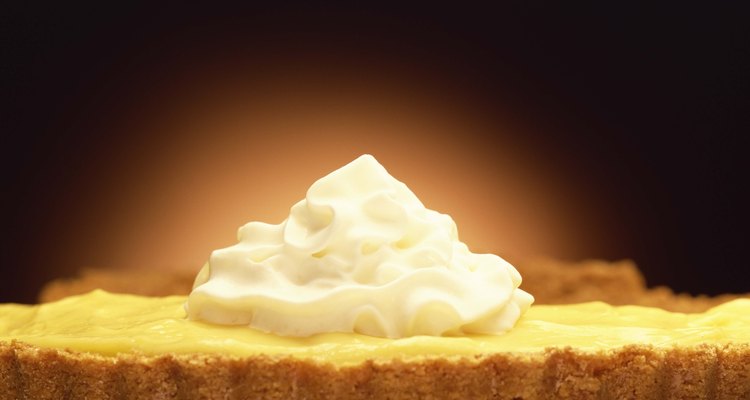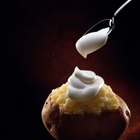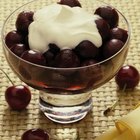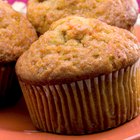
The lush richness of cream complements almost any dessert if it's lightly sweetened and flavored, and made thick enough to hold its shape. Whipping the cream works for toppings and garnishes, or for filling already-baked pastries. A more stable filling can be made by thickening the cream with eggs and starch, turning it into pastry cream. Pastry cream can be stored for days in the refrigerator, but might turn hard if it's improperly made or stored.
About Pastry Cream
If you whisk eggs into a quantity of cream and heat it gently, the proteins in the eggs will eventually begin to firm up just as they do in a skillet. Because the eggs are dispersed throughout the cream, they'll produce a soft, thick gel rather than the familiar fried-egg texture. Liquids thickened this way are called custards, and they make delicious fillings for baked goods. If they're baked, however, the eggs contract and lose their ability to thicken the mixture. pastry cream addresses this by thickening the cream with flour or cornstarch as well as the eggs, making a stable custard that can be baked or used cold.
The "Skin"
If you make up a batch of pastry cream and store it in a covered container, you might find after a day or two that it's developed a hard, leathery layer at the surface. If you've left any air space above the surface of the custard, this is normal. Moisture evaporates from the surface, drawing the custard's proteins closer together and forming the distinctive "skin." This can be avoided by pressing plastic wrap directly to the surface of the pastry cream as soon as it's cool enough to refrigerate. If a skin has formed on your pastry cream, lift it off carefully and use the remaining custard as usual.
Complete Hardening
Occasionally, you might find that your pastry cream has set into a single, solid lump in your storage container. This is almost always the result of an error in the written recipe, or not measuring your thickening starch accurately. Pastry cream recipes typically use flour, cornstarch or both. These starch-based thickeners continue to gel the mixture as it cools, and if you've used too much your cream will become unusably stiff. Most recipes use 1 1/2 to 2 tablespoons of cornstarch for each 1 to 1 1/2 cups of cream. If your recipe calls for significantly more, it's probably an error. Try scaling back the amount of starch in future batches, or use a different recipe.
Fixing It
If your pastry cream is thick and pasty but still spreadable, it's just slightly past the normal proportions of starch. You can usually make it usable by whipping it for a few seconds in a stand mixer or food processor, which will soften and aerate it enough to use. You can lighten it further by drizzling in a small amount of heated cream. For pastry cream that's set to a solid consistency, heat 1/4 cup or 1/2 cup of cream in a small saucepan and whisk in the thickened custard a spoonful at a time after each addition has dissolved completely into the mixture. Continue until the full amount is usable, adding extra cream if necessary. Strain out any lumps, and use the custard as usual.
Related Articles

What Do Bakeries Use in Their Whipped ...

Clotted Cream Vs. Double Cream

Adding Vanilla Pudding to Whipping Cream

Custard vs. Pastry Cream

What Is Tretinoin Cream Used For?

How to Make Scalded Cream

Can Any Over-the-Counter Creams Tighten ...

A Substitute for Meringue

Heavy Whipping Cream Vs. Half & Half

How to Make Whipped Frosting Without ...

Adding Cream of Tartar to Macaroons

How to Fix Runny Boston Cream Filling

Why Can't You Use Ultra Pasteurized ...

What Is "Cultured Cream"?

Can You Make Homemade Whipped Cream ...

Substitute for Manioc Starch

Why Does Milk Curdle When Baking a ...

How to Harden Up Whipped Cream

How to Thicken Cream Filling

Differences in Half & Half Vs. Cream ...
References
- On Food and Cooking: The Science and Lore of the Kitchen; Harold McGee
- The Professional Pastry Chef; Bo Friberg
Writer Bio
Fred Decker is a trained chef and prolific freelance writer. In previous careers, he sold insurance and mutual funds, and was a longtime retailer. He was educated at Memorial University of Newfoundland and the Northern Alberta Institute of Technology. His articles have appeared on numerous home and garden sites including GoneOutdoors, TheNest and eHow.
Photo Credits
Jupiterimages/Comstock/Getty Images